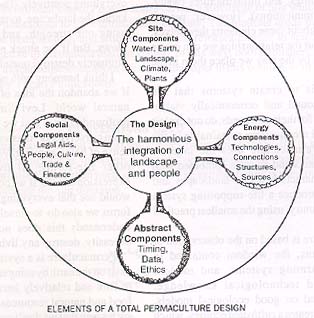
It is often the case that permaculture is mistaken for being just another form of organic gardening. This description is seriously lacking when considering permaculture and the influence it is having, and can have, in our rapidly changing world. “Permaculture is a design system for the harmonious integration of landscape and human habitat” (Mollison) An organic garden is only one element, an important element, but only one in an infinite number of different elements that might make up appropriately designed human systems. At the heart of good design are the functional relationships between elements and how they support each other. Permaculture is not about finding new and complicated high tech ways to support our present culture of waste and "protracted thoughtless labor". It is about integrating: site, energy, social, and abstract components to provide for human needs by creating and recycling resources and energy without degrading local and distant environments.
In the next few months we will be developing our own water, food, and animal systems here on Denman Island. Our system will be designed to provide for more than our own personal needs, as we are offering permaculture design courses and bringing in many people. As we go through the design process we will write about our efforts to implement permaculture design. Win , lose or draw we will reveal how easy or difficult it is to design a 1/4 acre lot starting from our front door. Through the process we will demonstrate how permaculture design is so much more than organic gardening.
Permaculture is not a hippie movement or a religion. Permaculture is a practical ethical way to move forward in a world of uncertain futures. The more we take responsibility for the cycle of resources around us, the richer and more abundant day to day life will be. The more connected we become to our community the more it will be there for us in the future.

Site Components
Water, earth, landscape, climate, plants
An appropriate design first considers local conditions and then harmonizes developed systems with those conditions to achieve that highest level of energy conservation possible.
Water, Access, Structures

This is the priority sequence of permaculture site design. By first designing water infrastructure (swales, dams, irrigation lines, diversion drains, irrigation ditches…) to harvest rainwater and store it passively throughout the landscape, we insure the fertility of the land and soil into the future. By storing, soaking and spreading water throughout the landscape we have preserved and even increased the health of the local ecology.
With the water system designed we can now turn our attention to accesses. The roads and trails must harmonize with the water system. All run off from roads and trails is directed passively to water harvesting structures like swales and dams. The compacted and sealed nature of access features results in flash run off during rain events. In a standard civil enegeneering situation this run off is a problem resulting in numerous logistical and environmental problems. In a harmonized permaculture design the run off from roads and trails are resources easily put to use in the whole system.
The final step in design, structures, is now easy, as building sites will become obvious against the backdrop of designed access and water. All water runoff from house and building sites is easily directed to the water systems.
The pattern of settlement development described above enriches the local environment through increased year round moisture, increasing the productivity of local soil conditions, often resulting in a surplus of usable energy as water stored in small earth dams up slope. The inceased moisture in the environment produces an ecology that supports and provides for the local inhabitant. Residents are required to use only enivronmentally safe products and activities, as any pollution produced is not carried away with the rain water but stays on site in the water harvesting structures. This is the ultimate feedback loop! In a permaculture design if we posion our environment we directly poison ourselves!!!
We have more to come in Part 2 "Energy Components" be sure to check back next week...



